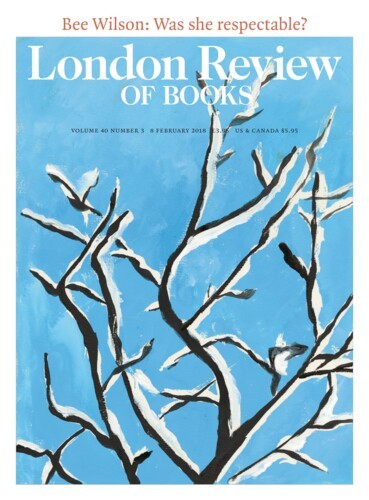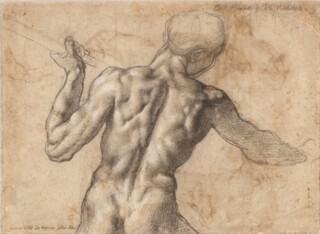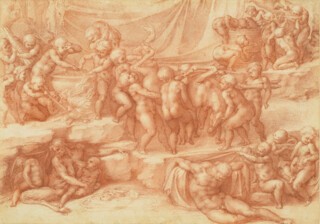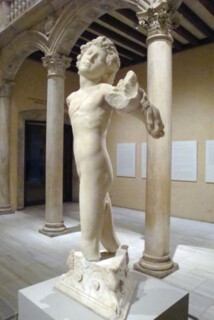A few days before his death in Rome in 1564 Michelangelo is said to have destroyed all the drawings in his house. He had done something similar on at least three previous occasions. But despite his efforts more than two hundred drawings are almost universally accepted today as being wholly or in part by his hand, and most experts would argue for a much higher figure. Substantial though these numbers are, it is clear that only a tiny fraction of the drawings that he produced has survived. For example, there are famous studies of individual figures on the Sistine ceiling, but only for three or four figures, though it seems virtually certain that he made similar drawings for every major figure, of which there are well over a hundred. The situation with his other major works in painting, notably the lost cartoon for a battle picture in the town hall of Florence, known as the Battle of Cascina, and the Last Judgment, is just as bad if not worse. About a hundred and thirty of the surviving drawings are currently on show in the Metropolitan Museum, including many of the most famous, in what must be one of the most comprehensive displays ever assembled. It includes examples of all the different types of drawing Michelangelo seems to have produced, from rough pen sketches to completed full-size cartoons, and covers every stage in his career.
It was normal practice among Florentine painters of his time to develop their ideas in drawings and to change these ideas only in minor ways when they were transformed into paintings. There was a practical reason for this, in that the prestigious and widely practised technique of fresco painting required meticulous planning in advance through drawings, establishing a clear distinction between conception and execution in the creation of paintings. This was not true to the same extent of sculpture, and drawings by sculptors are much less common than those by painters, so it is no surprise that relatively few of Michelangelo’s surviving drawings can be related to his own sculptures. Obviously, too, his architectural projects all had to be based on and developed through drawn plans. In short, most of Michelangelo’s drawings were made for strictly practical purposes, and once they had served their original function they were useful only for reference or as scrap paper.
Throughout history artists have tended to make a sharp distinction between finished works of art and the working material they use in creating them. Such material almost always remains the property of the artist, and at least until after the artist’s death it is not normally put on the market. Many artists of Michelangelo’s time seem to have preserved a good part of their drawings in case they might be useful at some later date, and some of their holdings subsequently passed to other artists. But Michelangelo was probably not alone in destroying his working drawings, and he clearly did not do so in a systematic way. Some of the drawings that have survived were probably left in Florence when he moved definitively to Rome in the 1530s, including instructions for his agents in the marble quarries with diagrams of blocks needed for an architectural project. Others were on pieces of paper which may have been preserved because they also contained notes, fragments of poems or drafts of letters, for example. Such drawings can be seen in New York, together with an outstanding selection of the small group of highly finished sheets that he made as gifts for a few close friends.
Apart from those that he gave away, most of the surviving drawings probably remained the property of Michelangelo’s relatives and were gradually dispersed, although many are still preserved in the family house in Florence. But until the 19th century the market for artists’ working drawings was extremely limited. The evidence that non-artists collected working drawings in the 16th century is very slight, but from the late 17th century there were a few such collectors, including some who assembled huge holdings. Painters too engaged in the collecting of drawings, one of the most successful being Thomas Lawrence, several of whose drawings are in the exhibition. Just how little value was attached to Michelangelo’s working material on paper is shown by the fate of the cartoon he made around 1504 for the Battle of Cascina, which was to be the companion piece to a large battle picture by Leonardo da Vinci. The composition, consisting almost entirely of male nudes, is known through an early copy included in the current exhibition. It was evidently greatly admired by other Florentine artists, who copied and then cut up the cartoon. Within a few years it had been destroyed, evidently because even Michelangelo’s fellow artists made no attempt to preserve any fragments once they had learned the lessons these provided.
This is not to say that there was no demand for drawings in Michelangelo’s own day. Those he gave away were original compositions, unrelated to any of his commissions. Although there are records of patrons and others asking for any drawings by his hand, it is doubtful whether they meant this literally. Even if they did, it does not follow that they had a taste for working drawings, or indeed for drawings at all. Michelangelo was one of the most famous men of his time, whose name was known to virtually every educated Italian. He was the subject of two substantial biographies published in his lifetime, and two more soon after his death. His fame is often discussed today in terms of the social status of artists, but this is rather misleading, if it has or had any sense at all. It had long been recognised that outstanding artists were in a category on their own, and reference was often made to the many anecdotes about the leading artists of classical antiquity, such as the painter Apelles, who was said to have painted Alexander the Great and then to have succeeded him as the lover of Campaspe, because Alexander recognised that as a painter he had a keener appreciation of her beauty than Alexander himself. In more recent times, both Giotto and Brunelleschi were exceptionally famous and not regarded as mere manual workers, but thought to possess unique talents. Michelangelo easily fitted into this pattern.
The demand for something by his hand was surely an early instance of the kind of celebrity culture with which we are now very familiar. Michelangelo’s contemporaries were certainly in awe of his personality, and this was probably not entirely unrelated to the fact that his name led to endless not entirely unserious suggestions that his work was angelic or divine. Today any sheet of paper that contains so much as a rough sketch by Michelangelo or a line of his very distinctive handwriting has acquired a cachet that makes it almost like a religious relic. Such a sheet gives, or seems to give, a direct access into his way of thinking and especially into his creative process – something that interests us much more than it interested his contemporaries. This issue is at the heart of the New York exhibition, which is necessarily much more about how he thought and worked than about the works he created for the public domain and on which his reputation was based.
One obvious problem with Michelangelo’s drawings has to do with attribution. The drawings he gave as gifts were frequently copied at the time, and there has been much discussion about whether surviving versions are originals or copies. Controversy has also surrounded drawings of a more practical kind. For example, Michelangelo certainly provided drawings for his friend Sebastiano del Piombo, and there was long uncertainty about which drawings associated with Sebastiano’s own paintings were by Michelangelo, and which by Sebastiano. Several of these were displayed last year at the National Gallery and two reappear in New York; but on the question of their authorship there is now wide agreement, although Bernard Berenson, for example, took a very different view from the one now accepted.* At stake is not just the status of the drawings themselves, but also the wider question of exactly what contribution Michelangelo made to Sebastiano’s paintings.
The drawings associated with Michelangelo’s own works also raise problems. This is partly because even these drawings could have been copied by other artists at an early date as part of their own education, or even by his own assistants. It is also clear that Michelangelo taught some of his own pupils and assistants how to draw, and there are individual sheets which seem to show the work of master and pupil. The distinction between different hands is not always easy to make, and art historians tend to credit Michelangelo himself only with those elements that seem particularly confident and accomplished. This assumption may not necessarily be correct, because even Michelangelo may on occasion have made a weak drawing, or at least a misplaced line. It is possible that some of the current claims about such drawings set the bar for his participation too high, and some suggestions, for example, that a few sheets are the work of more than two artists seem tenuous and over-speculative. Nor can we necessarily assume that when the outlines of a figure have been strengthened, this was done by someone other than Michelangelo.
The question of exactly what part of every drawing was made by Michelangelo himself is of great interest to curators of drawings and to collectors, but is often unlikely to have a definitive solution, however reluctant some of the specialists are to admit this. There is a strong subjective element in the process of attribution. Fortunately, for those who are interested in how Michelangelo worked, the issue of whether a drawing is an original or a copy is usually of only marginal importance.
The catalogue of the New York exhibition, which is too large to be carried easily, is unusual in format but very well conceived.† It consists mainly of a broadly chronological account of Michelangelo’s career written by the organiser, Carmen Bambach, centred on his drawings and especially on those on display. The chronological structure is also followed in the exhibition itself, except that the drawings associated with the ceiling of the Sistine Chapel are shown out of sequence, beneath a large reproduction of the ceiling itself. A particularly strong section is devoted to Michelangelo’s earliest drawings, which were indebted to those of his first teacher, the painter Domenico Ghirlandaio, although the pupil very soon surpassed his master in terms of skill. Also notable are the substantial groups of drawings for the main projects that occupied him for most of the two decades that followed the completion of the Sistine ceiling in 1512. The first of these was the huge tomb of Pope Julius II, who had commissioned the ceiling. Another was the design for the façade of the Florentine church of San Lorenzo, and the third was the Medici mausoleum in the new sacristy of this church.
These three projects have two things in common: they all involved an extraordinarily ambitious combination of the sculpture and architecture, and none was completed in the form Michelangelo intended, although Matteo Renzi, while he was mayor of Florence before becoming prime minister of Italy, rather implausibly proposed constructing the façade of San Lorenzo as a new attraction for tourists, on the basis of a wooden model made for Michelangelo which doesn’t show the intended relief sculptures. All of these projects were abandoned or modified because of lack of funds or the demands of new patrons, but it is doubtful whether any of them could ever have been completed as Michelangelo had proposed. Fortunately, after his departure from Florence the new sacristy was finished by other craftsmen with great tact and without much apparent reference to Michelangelo’s surviving designs.
Although the exhibition is more about the way Michelangelo worked than about the works he produced, there are three sculptures supposedly by him on display, none of them intact and none in any way typical: an unfinished bust of Brutus, an unfinished statue of a standing figure possibly representing David and possibly Apollo, and the so-called Manhattan Boy, a very damaged and puzzling figure first identified in New York about half a century ago, and then forgotten until the 1990s. The attribution has often been questioned, but there is good evidence that it was in a collection in Rome in the 1550s, with an attribution to Michelangelo recorded in several publications of the period. It then turned up a century later in another Roman collection, this time identified as an ancient statue, and was still there, seemingly intact, in the 1760s, although it is likely that by that time the right arm had already been broken and restored. In 1905 it emerged on the art market, with broken legs and with the feet, arms and much of a quiver missing, attributed to the School of Michelangelo. How the attribution to Michelangelo was lost, or why it was rejected, and how the statue was smashed and then only partly reconstituted have not been explained. Equally troubling are the implausibly elongated thighs of the figure and the huge difference in quality between this statue and the Bacchus now in Florence, which was said by one of Michelangelo’s earliest biographers to have been made for the same patron at about the same time. Another supposed early work on display is a painting from Fort Worth showing the Temptation of St Anthony, a composition based on an engraving by Martin Schongauer. If an early biographer had not reported that Michelangelo made such a picture as a student, it is doubtful whether anyone would have attributed this panel to him.
A better idea of Michelangelo’s artistic priorities is provided by the drawings he gave to his friends. The high finish of many of these has led several scholars to suppose they are copies, but this is not very convincing, as Bambach and most other specialists have recognised. In most of these drawings Michelangelo seems to have had a free hand in the choice of subject matter, which is often unconventional and extremely obscure. There is no obvious problem in understanding a drawing of Cleopatra in an exotic headdress, or one of Ganymede being carried up by Jupiter in the form of an eagle, but another drawing shows a naked man reclining against a globe, with a naked angel blowing a trumpet immediately above hm and more naked figures in the background, some embracing and others struggling, and yet another includes naked putti carrying a horse upside down, collecting water from a well and heating a huge cooking pot. More conventional in subject matter are the drawings on religious themes that he made for his exceedingly pious friend Vittoria Colonna. In all these drawings Michelangelo can be seen at his most personal. There is his usual obsession with the representation of male nudes with exaggerated musculature, now combined with an increasing piety and an apparent preoccupation with suffering and death. Similar concerns can be seen in his late frescoes, the Last Judgment and the decoration of the Pauline Chapel in the Vatican. The latter has always been difficult of access, and the former was controversial from the time it was unveiled, mainly because of the prominent display of male genitalia, which was not surprisingly thought inappropriate in the context of the altar wall of the papal chapel. Another criticism was that although Michelangelo’s figures were stupendous demonstrations of his skill in the depiction of the male nude in different poses – something that was considered particularly challenging – they were all stupendous in much the same way.
There is some justice in these criticisms, and it is telling that the Last Judgment, although in his lifetime the best known of Michelangelo’s works, was relatively uninfluential; and the same could be said of his other late figurative compositions, including those in his drawings, which were quite widely known through copies. Some of the least attractive objects in the exhibition are the small dull paintings made by Marcello Venusti from Michelangelo’s late religious drawings, which were much admired for their religious feeling but haven’t aroused much enthusiasm in later times. It was a good idea to include them, since they show Michelangelo’s limitations just as many of the earlier exhibits reveal his more familiar strengths. In any case, his main concern in his later years was not with painting or sculpture, but architecture, and here, especially in his designs for St Peter’s and for the Capitol in Rome, he was at his most inventive and original, taking a notably more independent approach than any of his contemporaries to the surviving buildings of antiquity.
Send Letters To:
The Editor
London Review of Books,
28 Little Russell Street
London, WC1A 2HN
letters@lrb.co.uk
Please include name, address, and a telephone number.




